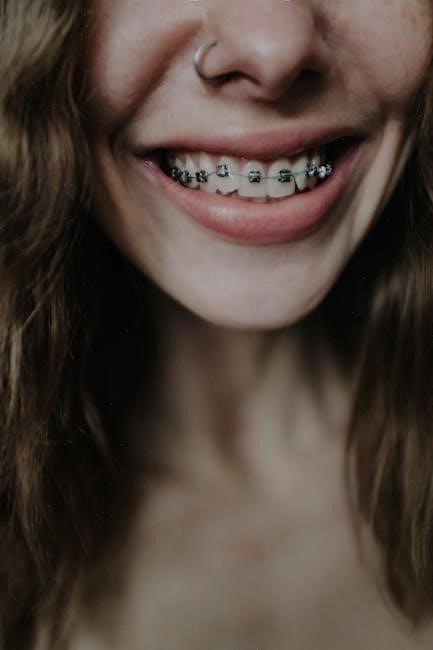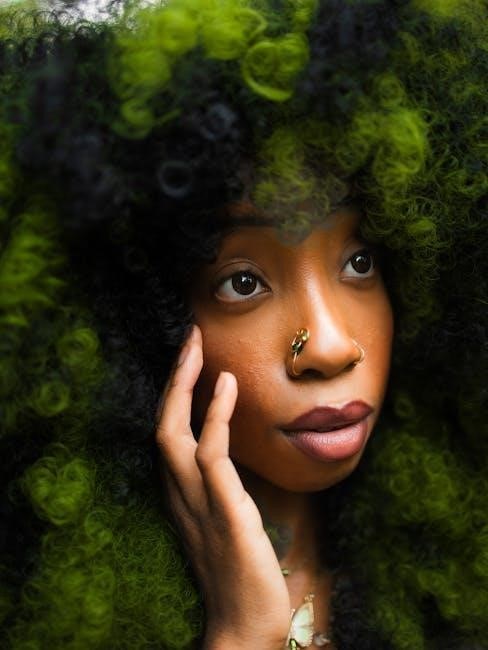Facial piercings are increasingly popular, offering diverse styles and self-expression; Understanding the risks, proper aftercare, and personal suitability is crucial for a positive experience.
Overview of Facial Piercings
Facial piercings have gained significant popularity, offering a unique way to express personal style and individuality. They come in various forms, including cheek, lip, nose, and ear piercings, each with distinct aesthetics and requirements. While some piercings, like nostril jewelry or lip studs, are considered elegant and subtle, others, such as eyebrow or bridge piercings, are less traditional and bolder. Pain levels vary depending on the piercing type and individual tolerance. Proper aftercare and understanding the healing process are essential to avoid complications. Whether for aesthetic appeal or personal significance, facial piercings allow individuals to showcase their identity creatively.
Popularity and Trends in Facial Piercings
Facial piercings have become increasingly popular, with trends shifting toward unique and expressive styles. While traditional piercings like nostrils and lips remain common, less traditional options such as eyebrow and bridge piercings are gaining traction. Social media and celebrity influences have played a significant role in their rise, showcasing their aesthetic appeal. Many view facial piercings as a form of self-expression, blending personal style with cultural or artistic inspiration. Despite their popularity, it’s important to weigh the risks and consider professional and social implications. The ability to customize jewelry and adapt piercings to individual preferences further enhances their allure and timeless appeal.

Types of Facial Piercings
Facial piercings include cheek, lip, nose, ear, and eyebrow piercings, each offering unique aesthetics and personal expression opportunities, catering to diverse styles and preferences.
Cheek Piercings (Dimple Piercings)
Cheek piercings, often called dimple piercings, involve piercing the cheek tissue to create a decorative effect. They can mimic natural dimples or enhance facial aesthetics. The piercing passes through the cheek into the mouth, requiring careful placement to avoid nerve damage. Pain levels vary, but many describe it as feeling like being pricked by two needles simultaneously. Healing times range from 6 to 12 weeks, with proper aftercare essential to prevent complications. Signs of rejection include tighter skin or jewelry migration. Regular cleaning and avoiding tight jewelry can promote healing. Cheek piercings are popular for their unique appeal but require commitment to maintenance and care.
Lip Piercings (Labret, Monroe, and Medusa)
Lip piercings are a popular choice for facial adornment, offering versatility in style. The Labret piercing is located below the lip, often featuring a stud that sits close to the chin. The Monroe piercing mimics Marilyn Monroe’s iconic beauty mark, placed on the upper lip. The Medusa piercing is centered above the upper lip, creating a striking aesthetic. These piercings are known for their bold appearance and can enhance facial symmetry. The procedure involves piercing the lip or surrounding tissue, with healing times varying from 6 to 12 weeks. Proper aftercare is crucial to prevent swelling and infection. Jewelry choices, like studs or rings, can elevate the look, but tight fittings may risk migration. Regular cleaning and avoiding irritants, such as spicy foods, aid in a smooth recovery. While relatively low-maintenance, lip piercings require attention to ensure long-term satisfaction and minimize complications.
Nose Piercings (Septum, Nostril, and Bridge)
Nose piercings are among the most popular facial piercings, offering a variety of styles. The septum piercing is placed in the thin cartilage between the nostrils, creating a bold yet versatile look. Nostril piercings are situated on the side of the nose and can be adorned with studs or rings. The bridge piercing, located on the top of the nose, is less common but striking. Proper aftercare is essential, with saline soaks recommended to prevent infection. Healing times vary, with septum piercings typically taking 6-8 weeks and nostril piercings up to 6 months. Jewelry choices, such as small studs or delicate rings, enhance the aesthetic. Regular cleaning and avoiding tight jewelry can help ensure a smooth recovery and prevent complications like migration or scarring.
Ear Piercings (Helix, Tragus, and Rook)
Ear piercings are a popular choice for facial adornment, with options like helix, tragus, and rook offering unique styles. The helix piercing is located on the outer rim of the ear and can be pierced multiple times for a layered look. The tragus, a small flap in front of the ear canal, adds a subtle, edgy touch. The rook, situated in the upper fold of the ear, is less common but striking. These piercings are relatively pain-free and heal quickly with proper care. Jewelry options include studs, hoops, or dainty rings, making them versatile for personal expression.
Eye and Eyebrow Piercings
Eye and eyebrow piercings are bold and striking, offering a unique aesthetic appeal. Eyebrow piercings are typically placed along the brow ridge and can be vertical or horizontal. They’re popular in subcultures for their edgy look and can be adorned with curved barbells or captive rings. Eye piercings, though less common, involve delicate areas like the eyelid or beneath the eye. These piercings require extreme precision due to the sensitivity of the area. While they can enhance appearance, they carry higher risks of complications. Proper aftercare is essential, and choosing an experienced piercer is crucial for safe and successful results.

The Piercing Process
The piercing process involves preparation, precise placement, and the actual piercing. A professional piercer uses sterilized tools to create the hole and insert jewelry safely.
Pre-Piercing Preparation
Pre-piercing preparation is crucial for a safe and successful experience. Research reputable studios and piercers to ensure sterilization and hygiene standards are met. Avoid alcohol and blood thinners 24 hours before the procedure to minimize bleeding and swelling. Maintain good hygiene by washing your hands and face thoroughly. Eat a light meal to stabilize blood sugar and avoid lightheadedness. Remove makeup to allow the piercer clear access to the area. Wear comfortable clothing for easy access to the piercing site. Bring a form of ID and any necessary paperwork. Proper preparation ensures a smooth process and reduces the risk of complications.
Choosing the Right Jewelry
Selecting the right jewelry for your facial piercing is essential for comfort, safety, and aesthetics. Opt for high-quality, hypoallergenic materials like surgical stainless steel, titanium, or niobium to minimize the risk of allergic reactions. Avoid cheap materials such as brass or fashion jewelry, as they can cause irritation. Consider the size and fit of the jewelry, ensuring it suits your piercing type and personal style. For example, studs are ideal for eyebrow piercings, while rings or hoops may suit septum or nostril piercings. Initial jewelry is often slightly longer to accommodate swelling. Always consult your piercer for recommendations tailored to your needs.
- Material: Surgical stainless steel, titanium, or niobium.
- Jewelry type: Studs, rings, hoops, or labrets.
- Size: Appropriate for the piercing location and swelling.
The Actual Piercing Procedure
The piercing procedure involves creating a precise opening in the desired location using a sterile needle. A professional piercer will mark the area, ensuring proper placement before proceeding. Using a hollow needle, the piercer will insert the jewelry through the tissue. The process is typically quick, with mild discomfort varying by location. After the piercing, the piercer will provide instructions for aftercare to promote healing.
- Marking the area for accuracy.
- Using a sterile, hollow needle for the piercing.
- Inserting jewelry immediately to minimize discomfort.
- Ensuring the piercer follows proper hygiene practices.

Aftercare and Healing
Proper aftercare ensures a smooth healing process, reducing the risk of complications. Regular cleaning with saline solution and avoiding tight clothing are essential.
- Daily saline soaks promote healing.
- Avoiding tight clothing reduces irritation.
- Monitoring for signs of infection is crucial.

Importance of Proper Aftercare
Proper aftercare is vital for facial piercings to heal effectively and prevent complications. It reduces the risk of infection, promotes tissue health, and ensures the piercing settles well. Neglecting aftercare can lead to prolonged healing times, scarring, or even rejection of the jewelry. A clean environment and consistent hygiene practices are essential to support your body’s natural healing process.
- Saline solution is a recommended cleaning agent.
- Avoid harsh chemicals or submerging the piercing in water.
- Proper care fosters a smooth recovery and long-term satisfaction.
Daily Cleaning and Maintenance
Daily cleaning is essential to maintain the health of your facial piercing. Use a saline solution (0.9% sodium chloride) to gently clean the area twice a day. Dip a clean cotton ball or gauze in the solution and lightly dab the piercing, ensuring no harsh rubbing occurs. Avoid using fragrant soaps, alcohol, or hydrogen peroxide, as these can irritate the skin. Keep the piercing dry between cleanings to prevent bacterial growth. Regular maintenance also includes avoiding tight clothing that may friction the area. By following these steps, you can support the healing process and keep your piercing clean and healthy.
- Clean twice daily with saline solution.
- Avoid harsh chemicals or fragrant products;
- Keep the area dry and avoid tight clothing.

Signs of Complications and Rejection
Identifying signs of complications or rejection early is crucial for maintaining your facial piercing’s health. Common indicators include excessive redness, swelling, or persistent pain beyond the initial healing phase. Pus or discharge, especially if thick or discolored, may signal an infection. If the piercing jewelry starts to migrate or appears uneven, it could be a sign of rejection. Increased sensitivity, a bad odor, or hardened skin around the piercing are also concerning symptoms. If you notice any of these, consult a professional piercer promptly to address the issue before it worsens.
- Excessive redness or swelling.
- Persistent pain or sensitivity.
- Discharge or pus with unusual color or consistency.
- Jewelry migration or rejection.
- Bad odor or hardened skin around the piercing.
Risks and Safety Considerations
Facial piercings carry risks like infections, allergic reactions, and nerve damage. Improper techniques or jewelry can lead to complications, emphasizing the need for a sterile environment and proper aftercare.
- Infections from unsterile equipment or poor hygiene.
- Allergic reactions to jewelry materials.
- Nerve or tissue damage during piercing.
- Gum or tooth damage with certain piercings.
Common Risks Associated with Facial Piercings
Facial piercings can pose several risks, including infections, swelling, and allergic reactions. Improper hygiene or low-quality jewelry may lead to complications. Nerve damage or scarring can occur if piercings are not done correctly.
- Infections from bacteria entering the piercing site.
- Swelling or redness, especially in the initial healing phase.
- Allergic reactions to certain metals in jewelry.
- Scarring from improper aftercare or piercing techniques.
- Nerve damage, particularly in sensitive areas like the lips or nose.
While rare, these risks highlight the importance of choosing a reputable piercer and following aftercare guidelines closely.

Understanding Rejection and Migration
Rejection and migration are common issues with facial piercings, where the body rejects the jewelry or the piercing site shifts. Rejection occurs when the immune system treats the jewelry as a foreign object, causing the piercing to push outward. Migration is when the piercing hole moves from its original position. Both can result in scarring or uneven healing.
- Causes include improper piercing technique, poor jewelry quality, or insufficient aftercare.
- Symptoms may include redness, swelling, or discharge around the piercing site.
- Addressing rejection early is crucial to minimize damage and prevent permanent scarring.
Professional advice is essential to manage these issues effectively and maintain the piercing’s integrity.
Allergic Reactions to Jewelry Materials
Allergic reactions to jewelry materials are a common concern for facial piercings. Nickel is a frequent allergen, causing redness, itching, and swelling. Even high-quality metals like gold or silver may contain nickel, so it’s crucial to choose hypoallergenic options like surgical stainless steel or titanium. Symptoms of an allergic reaction include skin irritation, rashes, or bumps around the piercing site.
- Avoid jewelry with nickel to prevent reactions.
- Opt for implant-grade materials to minimize risks.
- Consult a professional if symptoms persist or worsen.
Addressing allergies early ensures proper healing and comfort for facial piercings.
Personal Considerations
Personal considerations involve evaluating your lifestyle, pain tolerance, and professional and social implications before getting a facial piercing.
- Assess pain tolerance and discomfort levels.
- Consider lifestyle factors like job requirements or social environments.
- Evaluate the impact on professional and social life;
Considering these factors ensures a confident decision that aligns with your personal and professional life.
Pain Tolerance and Discomfort Levels
Pain tolerance varies significantly among individuals when it comes to facial piercings. Some find the process mildly uncomfortable, while others experience more pronounced discomfort. Areas with thicker tissue, like the nose or septum, tend to be more painful due to the density of cartilage. In contrast, piercings in softer areas, such as the earlobe or nostril, are generally less painful. The clamping sensation during the procedure can also cause temporary discomfort. It’s essential to assess personal pain thresholds and consider the after-discomfort, such as swelling or tenderness, which may persist for a few days post-piercing. Breathing techniques or mental preparation can help manage anxiety and discomfort.
Lifestyle Factors to Consider
Lifestyle factors play a significant role in deciding whether to get a facial piercing. Individuals with active jobs or hobbies involving physical labor may face challenges due to the risk of piercing damage. Smokers or those with frequent hand-to-face habits may experience slower healing or increased infection risks. Additionally, careers in conservative industries or jobs with strict dress codes may require piercings to be hidden or removed. Social environments also matter, as piercings may attract unwanted attention or judgment. Personal habits, such as playing sports or frequent travel, should also be considered to ensure proper care and avoid complications during healing.
Impact on Professional and Social Life
Facial piercings can significantly influence both professional and social dynamics. In conservative work environments, visible piercings may be perceived as unprofessional or inappropriate, potentially affecting career advancement. Certain industries, such as corporate or healthcare, often have strict policies against visible body modifications. Socially, piercings can attract attention, with some people viewing them as rebellious or unconventional. However, in creative or artistic circles, they may be celebrated as a form of self-expression. It’s important to consider how piercings align with personal and professional goals, as well as societal expectations, to avoid unintended judgments or limitations in social and professional settings.
Maintenance and Upkeep
Proper maintenance ensures facial piercings remain clean and secure. Regularly inspect jewelry for tightness, and avoid harsh chemicals that may damage materials or irritate skin.
Changing Jewelry Safely
Changing jewelry in facial piercings requires care to avoid irritation or damage. Always wait until the piercing is fully healed before making changes. Wash hands thoroughly and use sterile gloves. Use the correct tools, like a piercing needle or threader, to remove and insert jewelry. Avoid forced removal, as it can cause tearing. Opt for high-quality, hypoallergenic materials to minimize reactions. If unsure, consult a professional piercer for guidance. Clean the new jewelry with saline solution before insertion. Never share jewelry to prevent cross-contamination. Regularly inspect jewelry for signs of wear and replace it if necessary to maintain safety and aesthetics.
Upgrading Jewelry and Styles
Upgrading jewelry and styles for facial piercings allows for personal expression and aesthetic enhancement. Once fully healed, consider switching to higher-quality materials like solid gold or platinum for durability and style. Choose designs that complement your face shape and personal taste, such as minimalist studs or elaborate rings. Popular upgrades include larger gauges or decorative charms. Always consult a professional piercer to ensure the new jewelry fits properly and suits your piercing type. Proper aftercare is essential after an upgrade to maintain healing and prevent complications. Upgrading is a great way to refresh your look while ensuring long-term comfort and safety.

Addressing Common Concerns
- Concerns include rejection, migration, and infection risks.
- Allergic reactions to jewelry materials can occur.
- Social acceptance and professional implications may worry some.
- Pain during the procedure is a common fear.
Can Piercings Be Hidden for Work or Special Events?
Facial piercings can often be hidden for work or special events using discrete jewelry like clear retainers or small studs. For professional settings, some opt for removable jewelry to maintain a conservative appearance. However, removing jewelry during healing can cause complications, so it’s important to consult a professional. Choosing understated designs and high-quality materials can also help minimize visibility. This flexibility allows individuals to balance personal expression with professional or social requirements without compromising their piercing’s integrity.
How to Handle Rejection or Migration
If a facial piercing shows signs of rejection or migration, it’s crucial to act promptly. Consult a professional piercer immediately to assess the situation. They may recommend downsizing jewelry or switching to a different type to reduce irritation. Avoid tight or irritating jewelry, and ensure proper aftercare to prevent further complications. In some cases, migrating piercings can be stabilized with proper jewelry adjustments. If rejection progresses, removal may be necessary to avoid further damage. Keep the area clean and monitor for signs of infection. Early intervention can often save the piercing, but severe cases may require professional removal.
Healing Timeline
The healing process for facial piercings varies by type, with initial swelling subsiding within weeks. Full healing typically takes 6-12 months, requiring consistent aftercare.
Initial Healing Phase (0-2 Weeks)
The first two weeks are critical for healing. Swelling, redness, and mild discomfort are normal. Clean the piercing with saline solution 2-3 times daily to prevent infection. Avoid tight clothing or touching the area. Stick to a soft-food diet if it’s a lip or cheek piercing. Avoid smoking or alcohol, as these slow healing. Keep jewelry in place to allow the piercing to stabilize. Attend follow-up appointments if recommended by your piercer. Monitor for signs of complications, such as increased pain or swelling, and seek professional advice if they occur.
Intermediate Healing Phase (2-6 Weeks)
During this phase, swelling subsides, and the piercing becomes less tender. Continue cleaning with saline solution once or twice daily. Avoid tight jewelry or accessories that may irritate the area. Eating spicy or acidic foods can still cause discomfort, so opt for mild options. Keep the piercing moisturized but avoid heavy creams. While progress is visible, the piercing isn’t fully healed yet. Avoid changing jewelry yourself, as the hole is still fragile. Adhere to aftercare routines to prevent complications. Patience is key, as consistent care ensures proper healing and minimizes the risk of rejection or scarring.
Full Healing and Long-Term Care
Once the piercing is fully healed (typically 6-12 months, depending on the type), proper care is still essential. Clean the area occasionally with saline solution to maintain hygiene. Avoid tight or irritating jewelry that could cause friction. Keep the piercing moisturized but avoid harsh products. Regularly check jewelry for tightness or damage. Even after healing, avoid negligence, as piercings can still develop issues. For long-term care, opt for high-quality, non-reactive jewelry materials. Always handle the piercing gently to prevent accidental damage. Regular check-ups with a professional can ensure the piercing remains healthy and problem-free.

Social and Cultural Perceptions
Facial piercings carry diverse cultural meanings, from spiritual significance in ancient traditions to modern expressions of individuality. Societal acceptance varies widely, with some viewing them as artistic and others as unconventional.
Facial Piercings in Different Cultures
Facial piercings hold significant cultural and historical value worldwide. In many indigenous cultures, they symbolize spiritual strength, status, or tribal identity. For example, lip plates in African and some Asian cultures are traditional symbols of beauty and heritage. Similarly, septum piercings are common in certain Native American and South American communities, often tied to rituals or ceremonies. In contrast, Western societies have historically viewed facial piercings as rebellious or nonconformist. Modern global exchange has blurred these lines, with traditional practices inspiring contemporary trends. Each culture’s approach reflects its unique history, values, and aesthetics, making facial piercings a diverse expression of human identity.
Social Acceptance and Stigma
Social acceptance of facial piercings varies widely depending on cultural context and personal perceptions. While some view them as a form of self-expression and art, others may perceive them as rebellious or unprofessional. In recent years, facial piercings have become more mainstream, particularly among younger generations, but stigma persists in certain environments, such as traditional workplaces or conservative communities. Professional settings often influence whether piercings are deemed acceptable, with some industries embracing individuality while others maintain stricter appearance standards. Despite growing acceptance, individuals with facial piercings may still face judgment or bias, highlighting the ongoing tension between personal freedom and societal expectations.

Final Thoughts
Facial piercings are a personal journey of self-expression and confidence. Embrace the process, and remember, the right piercing can truly enhance your unique beauty and individuality.
Is a Facial Piercing Right for You?
Deciding if a facial piercing is right for you involves reflecting on personal style, pain tolerance, and lifestyle. Consider your professional commitments, as some workplaces may have policies against visible piercings. Think about your daily routines and how a piercing might fit into them. Research different types to find one that aligns with your aesthetic and comfort level. It’s also crucial to assess your ability to commit to proper aftercare. Ultimately, a facial piercing is a personal choice that should reflect your identity and confidence. Take your time to weigh the pros and cons, and consult a professional piercer to ensure it’s a good fit.
Facial piercings can be a transformative way to express your individuality and enhance your personal style. While they require careful consideration and commitment to proper care, the rewards of self-expression and confidence are well worth the effort. If you’ve done your research, chosen a reputable piercer, and feel ready to embrace the process, take the leap! Remember, your body is your canvas, and a well-chosen piercing can be a beautiful reflection of your unique spirit. Embrace the journey, stay informed, and enjoy the journey of personal growth that comes with this meaningful form of self-expression.